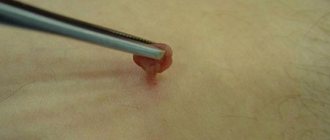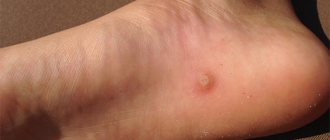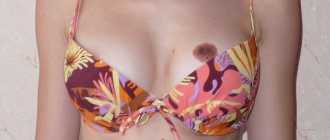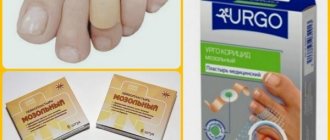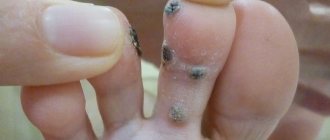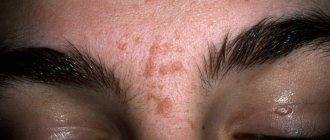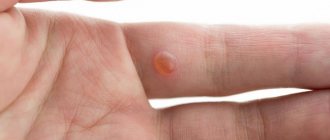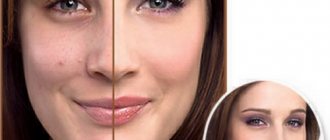A wart on the heel is a formation of viral origin, resulting from activation of HPV in the body. It grows gradually, imperceptibly. A distinctive feature is a rough tubercle that does not protrude above the surface of the skin. There is a deepening inwards and in breadth. The growth does not differ in color from the surrounding tissues or has a yellowish, white color. The most common location is the heel. The growths are located on the supporting part and cause pain.
Causes
The cause of warts on the heel is usually microscopic cracks that appear on the legs. Infection can be acquired in establishments such as baths, steam rooms or fitness centers. The virus is able to hide its activity for a long time, gradually destroying epidermal tissue.
Over time, neoplasms begin to form, which, after entering the active phase, are quite difficult to cure. Sometimes this takes about a year.
Symptoms
If measures are not taken in a timely manner, the wart begins to progress, disrupting the structure of the upper tissues. This provokes pain when moving.
Symptoms of warts or condylomas do not appear immediately, but gradually. Therefore, it is necessary to remember the main signs so as not to start an infection:
- A smooth spot appears on the surface of the skin, which begins to roughen over time.
- A hardened plaque is formed, which does not stand out relative to the upper layer of the epidermis.
- The affected area of skin begins to grow in height and width, forming a characteristic growth.
- The middle of the new growth has a body color with a bluish or yellow tint.
- A wart does not have the structure of normal healthy skin.
If suspected, a wart can be identified visually. To do this, you need to steam your feet and then rub your heel with a rough brush.
Naturally healthy areas of the skin (the upper stratum corneum) will be removed and problem areas will reveal themselves. A darkened growth will appear that may hurt, burn, or sting when walking. Sometimes, rubbing them with shoes causes slight bleeding.
For comparison, photos of warts on the heel can be found on the Internet.
Read here: Warts on the legs: which doctor to see and advice on choosing treatment. How to remove a wart with your own hands (105 photos)
What is a heel wart?
A heel wart is a type of plantar wart and is a hard formation on the skin of the heel of the foot, raised above the surface and covered with keratinized epithelium.
In fact, it is a benign tumor caused by the human papillomavirus (HPV). In the International Classification ICD-10, these warts are coded B07.
In appearance, a heel wart is a round-shaped compaction with a diameter of up to 20–25 mm, which rises above the skin by 1–2 mm. Its color usually does not differ from the skin, but sometimes has a pinkish or brownish tint.
In the initial period, the wart has a smooth surface, but gradually becomes rough due to the layering of the epidermis. The formation takes on a yellowish tint.
As a rule, single warts are observed. An increase in the number of growths indicates dangerous HPV activity. Sometimes a wart on the heel forms a “mosaic” network of many small growths.
Surgical intervention
The most primitive way to get rid of a wart on the heel of a child or an adult is removal using a scalpel and anesthesia. However, there are other, more gentle methods for removing warts from the heel.
Modern medicine has long used laser and ultrasound technologies, but unfortunately they are not available in all clinics. Special medical institutions may offer the following treatment:
- Laser therapy is more of a cosmetic procedure in which tissue is restored using special laser beams.
- Electrocoagulation is caused by cauterization of external growths, which usually leaves scars.
- Cryodestruction is the removal of warts using liquid nitrogen at a temperature of 195ºC. This method is considered the most popular due to its effectiveness and minimal pain.
It is worth noting that the above methods are used only in cases where there are multiple growths and neoplasms on the patient’s body. Such operations can only be performed by qualified specialists.
Diagnostics
Traditional dermatoscopy is carried out using a special optical device - a dermatoscope.
If you suspect the appearance of a wart in the heel area, you should seek medical help. Such diseases are treated by a dermatologist or dermatovenerologist. He will be able to identify the tumor and select the optimal method of removal.
Removal of a painful wart on the heel should not be performed until the diagnosis has been completed. Initially, the specialist visually assesses the affected area and scrapes the top layer of the epithelium. In most cases, these measures are sufficient to make a diagnosis.
In particularly difficult situations, the dermatologist refers the patient to dermatoscopy. Thanks to the hardware research method, it is possible to study the structure of the wart in detail.
For large growths, an ultrasound may be required. Diagnostics will allow you to determine the depth of the lesion and germination of the tumor.
For diagnosis, you need to contact a dermatologist, who usually only needs a visual examination and questioning of the patient.
Next, a biopsy of the formation will be performed to determine the type and strain of the virus. Additionally, general blood and urine tests are done.
Drug treatment
This method is considered the most common in medical practice. Treatment is carried out using medications in the form of alkalis and acids, followed by the use of healing and restorative ointments. Among them the following components and solutions can be noted:
- Tretinion, Solcoderm, Kolomak are salicylic acids with an admixture of nitrogen.
- Lapis pencil is a preparation containing silver nitrate. When combined with water, it oxidizes and negatively affects the tissues of the formations.
- Salipod is a patch that is often used to remove warts on a child’s heel.
- Verrucacid is a high concentration solution that helps eliminate the virus. Used to lubricate tumors.
- Kreofarma and Wartner Cryo are medications with a freezing effect. They cause cell death, accompanied by pain, after which the wart can be removed.
- Potassium permanganate and iodine for treating the affected foot.
After treatment with these drugs, it is necessary that the wounds left after warts heal faster. To do this, use various healing creams or ointments.
Why are they dangerous?
Some of the unsafe aspects for human health in the presence of growths on the feet include:
- A plantar wart grows all the time, and therefore causes excruciating pain when the patient tries to step on the foot.
- Formations can multiply. When the spine is injured, it can cause infection of nearby tissues and lead to the formation of new warts.
- Neoplasms are a source of transmission of the virus, creating a danger to others
- In rare cases, growths can become malignant, causing cancer.
Signs indicating the beginning of the degeneration of the spine on the heel:
- Color, shape, size changes.
- Bleeding appears, ichor and pus are released.
- Education smells bad.
If you have a number of symptoms, you should seek help from a specialist.
Home methods
Traditional medicine, in turn, is also an effective method for eliminating tumors. In addition to the well-known steaming of legs and spells, there are many folk recipes that can cope with the disease no worse than expensive medications.
Among these, the following recipes can be noted:
- a mixture of propolis and rowan juice;
- milkweed juice;
- solution of acetic acid and glycerin;
- dandelion juice;
- garlic juice;
- celandine grass juice;
- castor oil;
- wood ash.
Regardless of what kind of warts may appear on the heel, cauterization in most cases is an effective but painful method.
Prevention
To prevent pathology on the heel, you should follow a number of recommendations.
- Wear comfortable shoes that fit
- When walking in the shower or swimming pool, wear rubber slippers
- Don't buy larger shoes
- Care for the skin of the feet with ointments and creams
Formation on the heel is a rather unpleasant ailment. But if you approach the issue competently and in a timely manner, be it a wart, callus, polyp or melanoma, you can quickly get rid of it.

